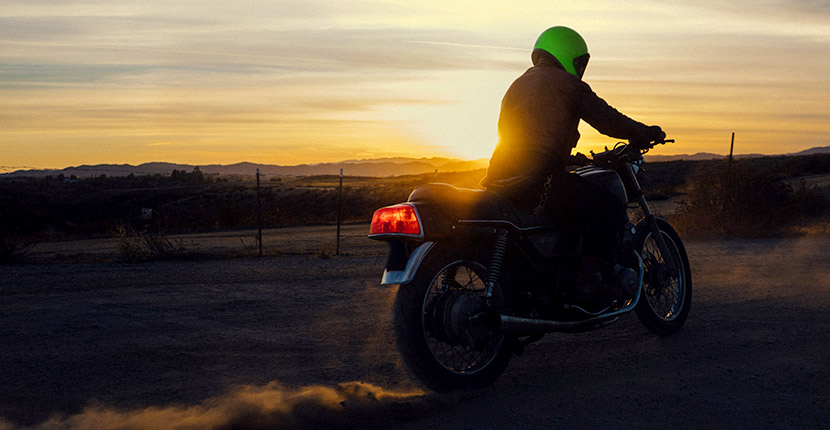How to Maintain Your Motorcycle Battery
- by Bryan Veldboom - updated on 4/28/2022

During these prime motorcycle months, it's important to maintain your battery in order to keep your bike performing properly. Here are a few battery maintenance tips to help you make the most of the riding season.
Select the Right Battery for Your Motorcycle
This may seem obvious, but with so many different types of batteries available, it's easy to pick the wrong one. When selecting a replacement battery, you want to pay attention to four things: size, voltage, CCA (cold cranking amps) and chemistry.
- Size - It's important that your replacement battery has the proper physical dimensions in order to fit your bike
- Voltage - Most motorcycles will run on 12-volt batteries, however, a select few will take a 6-volt battery; the battery you choose must match the voltage requirements of your motorcycle
- CCA - Cold cranking amps tell you how well your battery will perform in cold weather; motorcycle manufacturers provide CCA requirements for each model they produce
You can find the correct ratings for all of these categories by looking at your old battery, or by consulting your owner's manual or the manufacturer's website.
Motorcycle Battery Chemistry
There are also a number of different battery chemistries available, including flooded lead acid, AGM (Absorbed Glass Mat) and lithium iron phosphate. Choose the one that will give you what you want performance-wise. One thing to keep in mind though, if your bike's current battery is an AGM, you should never downgrade to a flooded battery unless your owner's manual says that it's okay. Also, not all bikes are suitable for lithium batteries, so make sure that your model will run a lithium battery prior to purchase. Here is a breakdown of the pros and cons of each chemistry:
Flooded
- Most affordable battery
- Shortest lifespan - will not last as long as an AGM or lithium battery
- Maintenance required - plates must be topped off periodically with distilled water
AGM
- More costly than a flooded battery
- Longer lifespan - lasts 2-3X as long as flooded batteries
- Maintenance free - completely sealed & spill-proof
- Higher voltage output - provides more energy than flooded batteries for more reliable vehicle starting
- Fast charging
- Lower self-discharge rates - holds its charge for longer in storage
- More resistant to vibrations and extreme weather
Lithium Iron Phosphate
- Highest cost up-front - will save you money over time due to lithium's longer lifespan
- Longest lifespan - lasts up to 2,000 cycles
- Maintenance free - completely sealed & spill-proof
- Highest voltage output - provides more energy than flooded & AGM batteries
- Fast charging - recharges 2X faster than lead acid equivalents
- Lowest self-discharge rate - holds onto its charge for much longer than flooded & AGM batteries, making it great for seasonal use
- Ultra lightweight - over 2X lighter than lead acid equivalents
Bike Battery Checklist - Quick Tips to Extend the Life of Your Battery
Now that you have the correct battery, keep it healthy by making these battery maintenance tasks a part of your monthly routine.
- Check cables, clamps and the battery case for obvious damage or loose connections
- Make sure the exhaust tube is free of kinks and clogs
- Test the battery's performance with a hydrometer or voltmeter
Check Your Battery's Fluid Levels
When you charge a flooded battery, it loses water due to evaporation. In order to maintain the battery's electrolyte, you need to occasionally top off the battery with distilled or deionized water. Keep in mind that this is only for flooded batteries. If you have an AGM or lithium battery in your bike, you can skip this process entirely.
Make sure to wear gloves and protective glasses when filling the battery and work in a well-ventilated area. This kind of maintenance should be done throughout the riding year. The more you ride, the more frequently your battery's fluid levels should be checked.
How Do You Clean Corrosion Off Battery Terminals?
Corrosion can build up on your battery's terminals, limiting the amount of power that travels from your battery to the engine, while also making it difficult to recharge. To eliminate corrosive buildup, scrub your terminals using a terminal post and clamp brush and a battery cleaner. If you don't have a battery cleaner, you can make one yourself by combining baking soda with water.
Make sure the vent caps are tight to prevent the cleaner from entering the battery's cells. Wipe them off with a wet towel and dry with another towel. Once the terminals have completely dried, you can apply a bit of anti-corrosion spray or place a battery terminal protector washer on the terminals to stop them from corroding in the future.
What Kind of Battery Charger Do I Need for a Motorcycle?
Be sure to connect your battery to a motorcycle battery charger when it's not being used for longer periods of time. This will help keep it at an optimum level of charge. Usually, you'll do this more during the winter, but a charger can still be used during the riding months when your bike isn't being driven regularly. Learn about the different types of chargers for your motorcycle in our blog.
Batteries Plus Sells Replacement Batteries, Chargers and More
At Batteries Plus, you'll find everything you need to keep your motorcycle road-ready. Shop our selection of motorcycle batteries, battery chargers and headlight bulbs. If your battery is having a hard time holding a charge, bring it to your nearest Batteries Plus location and we'll test it for you, free of charge. You can also learn more about motorcycle batteries on our blog. Some related topics include "Prepping Your Warm Weather Toys for Another Season" and "X2Power is the Best Battery Brand for Your Powersport Needs."